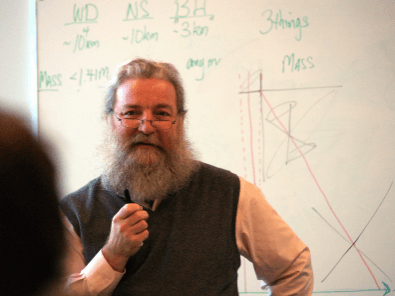Professor David Helfand Shares Small Teaching Changes with a Big Learning Impact
 David Helfand, Professor and Chair of the Department of Astronomy, will be featured in an upcoming faculty panel at the Center for Teaching and Learning on Wednesday, November 1 titled Small Teaching Changes, Big Impact: Science Faculty Report on their Practices.
David Helfand, Professor and Chair of the Department of Astronomy, will be featured in an upcoming faculty panel at the Center for Teaching and Learning on Wednesday, November 1 titled Small Teaching Changes, Big Impact: Science Faculty Report on their Practices.
All members of the Columbia community are invited to attend. Participants will learn about active learning strategies being used in Columbia University classrooms, engage in conversation with the faculty panelists, and share their strategies with colleagues.
Ahead of the event, Professor Helfand shares a few small changes he made to his teaching that led to big impacts on students’ learning.
What do you teach at Columbia?
I primarily teach general education science courses. Frontiers of Science is required of all first-year College students and is taught in 20-student seminars. My other courses are 75-100-student lecture courses in astronomy and physics designed for non-science majors needing to complete the science requirement.
What teaching challenge did you encounter while teaching your course?
One challenge I faced was making students comfortable with the fact that collaborative peer-to-peer learning is effective, regardless of their comfort level with the class material. After teaching in the inaugural semester of Quest University Canada (a radically innovative, new liberal arts institution I helped to design and then led as President for 7 years), I returned to Columbia enthusiastic about some of the collaborative learning techniques I had encountered there.
I had a small class that term of 24, so I would bring only 12 worksheets to class such that the students would have to share and work together. I found each pair of students placed the worksheet between them and turned to the right and left, respectively, to work alone on the problem presented.
What small changes did you make to address this challenge?
At Columbia, I begin the first class with a quiz, which I hint is an important test of their appropriateness for the class so as to induce a little stress. I then stop them before anyone is finished (adding a little stress), but then tell them to collaborate with their neighbor on the first question to arrive at a consensus answer. There is one right answer, but there are so many permutations that essentially everyone gets at least part of it wrong.
I ask for a team to volunteer and write their response on the board, correcting any mistakes as I go. I then ask:
‘How many people changed their original answer after consulting with a peer?’ (The result is always between 90 and 100 percent.)
‘Was the final answer closer to the right one?’ (Again, 90-100 percent answer yes).
‘And so,’ I conclude, ‘we have just demonstrated that there are 80 people in this class you can learn from, not just one.’ After several weeks of collaborative learning activities in lecture, more than 90 percent of the students reported liking the group work as an aid to their comprehension of the material.
Why this approach? Did it work the first time you used it?
It did work well the first time, but it is important to note that this was eight years after my first experience described above. I believe students in high school these days are more familiar with collaborative learning environments, so I don’t attribute its success entirely to my inventiveness.
Related Resources
Felder, R. and Brent, R. (2016). Teaching and Learning STEM: a practical guide. San Francisco, California: Jossey-Bass. (available as an ebook through Columbia Libraries; see page 163 on peer instruction; page 246 on cooperative learning).